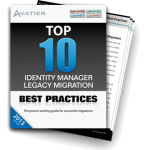Today’s enterprise IT support organizations and help desks are experiencing a shift in the way technologies are developed, deployed and consumed. As with identity management, all applications and systems are evolving faster than ever, with new cloud-based solutions emerging to replace on-premise software of generations past. User expectations aren’t far behind; a new generation of tech-savvy users increasingly expect the latest and greatest, including mobile compatibility. The result is a constantly evolving portfolio of applications and technologies that IT organizations must support, while being more responsive and empathetic than ever before.
As always for support, progress is a double-edged sword, because IT is responsible for enabling company-wide productivity. We sit squarely under the collective corporate microscope. User satisfaction is now at the forefront as new technologies enable more efficient communication, which is both support boon and bane. Seeking comments and anticipating issues are keys to effective support. New technologies are also simplifying the feedback process.
I’d like to address a couple items impacting the way IT support organizations operate:
- Productivity pressures
- Raising the bar on service and self-service
IT Support Productivity Pressures
Perhaps no single organization is as vital to company-wide productivity as IT. While most organizations are responsible for their own efficiency, IT ultimately owns that for the entire enterprise. Driving efficiency across an entire organization comes down to two key areas: tools and procedures. IT must effectively select and employ both to keep everyone happy and productive.
Raising the Bar on IT Support Services
IT is and always will be a service organization whose goal is to create a safe, productive environment for employees and businesses to operate. For too long, IT organizations have focused on technology rather than users, but a transformation is occurring in identity management and elsewhere. Today’s IT organizations are being encouraged to adopt a customer service view of IT support where customer satisfaction is the new measuring stick.
This is partly driven by IT’s desire for continual process improvement, and partly driven by more demanding users. In an effort to align operations with the business and provide better service to their customer base, many IT teams are actively implementing industry standard best practices, including IT service management (ITSM) process- improvement methodologies.
User requirements for the speed and quality of IT support are now much higher than ever before. IT organizations must adjust their focus towards their primary mission: delivering immediate, high-quality services that will be consumed by people, rather than spending excessive time tending to the underlying support technology that helps deliver these services. To ensure that they’re on the right track and delivering the best possible service, it’s essential for the IT team to continually seek feedback from their customers using surveys and other quantitative methods.
Self-service Portal Employee Empowerment
Like with identity management support, IT organizations are learning that it’s no longer possible to dictate how users receive service. Self-service is already an increasingly common part of daily life, and users expect resources that help them answer their own questions. Providing online wikis, forums, FAQs, knowledge bases and contextual videos are simple ways to provide the 24-hour support users assume. For this reason, many customer support solutions include self-service capabilities as coverage.
Agile IT Support Teams
Coping with today’s rapidly changing IT environment requires an agile team that’s willing to adopt new technologies and take measured risks to better serve their internal customers. Self-service portals help IT support manage volume requests by empowering users. As a result, support organizations must be ready to stay vigilant and improve documentation as part of operations. In order to better serve users at scale, support must simultaneously harness feedback to adapt and improve processes and foresee issues. This information brings an additional value. Using robust analytics regarding what users view and search for, IT support gains visibility into user problems, new support topics, and engineering considerations.
Get the Top 10 Identity Manager Migration Best Practices Workbook
 Start your migration from legacy software with the Top 10 Identity Manager Migration Best Practices Workbook. Use this workbook to think through your information security risk before you transition to next generation identity manager software.
Start your migration from legacy software with the Top 10 Identity Manager Migration Best Practices Workbook. Use this workbook to think through your information security risk before you transition to next generation identity manager software.




